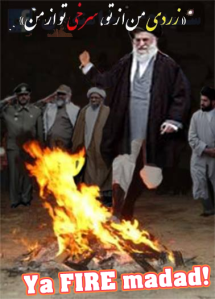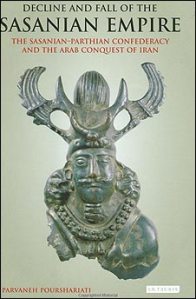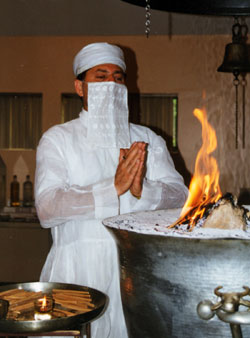 Nora Elisabeth Mary Boyce (2 August 1920 – 4 April 2006) was a British scholar of Iranian languages, and an authority on Zoroastrianism. Boyce was anything but a fanatic or ‘Islamist’ who wanted to bad name Zoroastrianism and Pre-Islamic Persia. A quote from Wikipedia shows that if anything she did her utmost (and apparently succeeding in many fields) to clarify many misconceptions about Zoroastrianism:
Nora Elisabeth Mary Boyce (2 August 1920 – 4 April 2006) was a British scholar of Iranian languages, and an authority on Zoroastrianism. Boyce was anything but a fanatic or ‘Islamist’ who wanted to bad name Zoroastrianism and Pre-Islamic Persia. A quote from Wikipedia shows that if anything she did her utmost (and apparently succeeding in many fields) to clarify many misconceptions about Zoroastrianism:
Category Archives: Majoosi Sassanism UNVEILED
Next-Of -Kin Marriage In Zoroastrianism & Pre-Islamic Persia – An undeniable fact
 In Zoroastrian Middle Persian (Pahlavi) texts, the term xwēdōdah (Av.xᵛaētuuadaθa, khevtuk-das) is said to refer to marital unions of father and daughter, mother and son, or brother and sister (next-of-kin or close-kin marriage, nuclear family incest), and to be one of the most pious actions possible. The models for these unions were found in the Zoroastrian cosmogony. Men were allowed to marry their daughters, sisters, and mother. It was “not merely tolerated, but indeed regarded as acts of piety and great merit, and even efficacious against the demonic forces.” The religious leaders of the time promoted marriage within the family, claiming it imitated the creation. Moreover, priests claimed that incestuous marriage “produced stronger males, more virtuous females, and higher quality and quantity of children, and it protected the purity of the race and propagated it.” This was met by much resistance, led to more conversions from Zoroastrians to Christianity, and is thought to have led to the downfall of the Zoroastrian religion. Finally, The number of wives a man had, was reliant on the means of the man. Thus, there wasn’t as much polygamy in the lower classes as in the wealthy class because men could not afford it.
In Zoroastrian Middle Persian (Pahlavi) texts, the term xwēdōdah (Av.xᵛaētuuadaθa, khevtuk-das) is said to refer to marital unions of father and daughter, mother and son, or brother and sister (next-of-kin or close-kin marriage, nuclear family incest), and to be one of the most pious actions possible. The models for these unions were found in the Zoroastrian cosmogony. Men were allowed to marry their daughters, sisters, and mother. It was “not merely tolerated, but indeed regarded as acts of piety and great merit, and even efficacious against the demonic forces.” The religious leaders of the time promoted marriage within the family, claiming it imitated the creation. Moreover, priests claimed that incestuous marriage “produced stronger males, more virtuous females, and higher quality and quantity of children, and it protected the purity of the race and propagated it.” This was met by much resistance, led to more conversions from Zoroastrians to Christianity, and is thought to have led to the downfall of the Zoroastrian religion. Finally, The number of wives a man had, was reliant on the means of the man. Thus, there wasn’t as much polygamy in the lower classes as in the wealthy class because men could not afford it.
Nowrooz & Chahārshanbe Suri – Pagan superstitions revered by Iranian natioanlists & Shia clerics
 Here some facts that are unknown to many who blindly follow their elders by celebrating this dangerous and pagan festival of polytheism:
Here some facts that are unknown to many who blindly follow their elders by celebrating this dangerous and pagan festival of polytheism:
Chahārshanbe Suri (Persian: چهارشنبه سوری) is a fire jumping festival, celebrated in Iran. It is the celebration of ancient fire worshippers (although in fairness,some Zoroastrian Priest themselves vehemently reject this practice!). Loosely translated as Wednesday Light, from the word sur which means light in Persian,or more plausibly, consider sur to be a variant of sorkh (red) and take it to refer either to the fire itself or to the ruddiness (sorkhi), meaning good health or ripeness, supposedly obtained by jumping over it is an ancient Iranian festival dating back to at least 1700 BCE of the early Zoroastrian era. Also called the Festival of Fire, it is a prelude to Nowrooz, which marks the arrival of spring. As for Nowrooz then it is sanctified in the heretical Twelver Shi’ite sect as one of the greatest day of mankind (!), they have fabricated a number of narrations and their top scholars – amongst the dead and living – all approve Nowrooz and declare it holy:
Pan-Iranism – AN EPIC FAIL
 The late Shah was one of the strongest advocaters of Pan-Iranism, a concept that totally failed, because of the deep racist nationalism amongst the Persian elite (who make up hardly more than 49% of the population of Iran) and the majority of Iranic people like the Baloch, Pashtun, Tajiks etc. who are proud Sunni Muslims. Apparently they call to the unity of all Iranic people, this includes the Kurds, Baloch etc. yet these groups during the Shah’s and even worse in the Shia Safawi reign are one of the most oppressed and deprived people inside the Iranian state. And then there are the Arabs of Iran who could be described with no exaggeration as one of the most deprived and oppressed people of Iran, they can smell the oil being carried from their soil to Tehran (most of Iran’s oil is based on soil where Arabs make up the majority!), yet they are literally completely deprived of it.
The late Shah was one of the strongest advocaters of Pan-Iranism, a concept that totally failed, because of the deep racist nationalism amongst the Persian elite (who make up hardly more than 49% of the population of Iran) and the majority of Iranic people like the Baloch, Pashtun, Tajiks etc. who are proud Sunni Muslims. Apparently they call to the unity of all Iranic people, this includes the Kurds, Baloch etc. yet these groups during the Shah’s and even worse in the Shia Safawi reign are one of the most oppressed and deprived people inside the Iranian state. And then there are the Arabs of Iran who could be described with no exaggeration as one of the most deprived and oppressed people of Iran, they can smell the oil being carried from their soil to Tehran (most of Iran’s oil is based on soil where Arabs make up the majority!), yet they are literally completely deprived of it.
In fact the Iranian nationists went to such extremes to deprive …
Zoroastrianism – A misunderstood monotheistic religion?
By SonsOfSunnah
 Al-Hamdulillah, there are not many people today who dare to to repeat clear-cut lies like: Muslims worship the Ka’ba! It couldn’t get more ridicolous by accusing the purest monotheists on earth i.e. the Muslims of polytheism. The ignoramus tried it with the ‘moon god theory‘ and worse than that was the ‘Muslims worship the Ka’ba theory’. As a matter of fact in Islam (unlike Rafidi Shi’ism, Christianity, Hinduism, Zoroastrianism) ALL forms of worship are directed to the CREATOR ALONE i.e. there is no such a thing as:
Al-Hamdulillah, there are not many people today who dare to to repeat clear-cut lies like: Muslims worship the Ka’ba! It couldn’t get more ridicolous by accusing the purest monotheists on earth i.e. the Muslims of polytheism. The ignoramus tried it with the ‘moon god theory‘ and worse than that was the ‘Muslims worship the Ka’ba theory’. As a matter of fact in Islam (unlike Rafidi Shi’ism, Christianity, Hinduism, Zoroastrianism) ALL forms of worship are directed to the CREATOR ALONE i.e. there is no such a thing as:
Faking Yazdgerd – Anti-Arab forgery
Faking Yazdgerd
Anti-Arab forgery
Persians forced into becoming Muslim?
 There is no doubt that the Safavids forced Shi’ism upon most Iranian, what about the early Muslims who conquered Persia in during the Caliphate of ‘Omar Ibn al-Khattab (may Allah be pleased with him)?
There is no doubt that the Safavids forced Shi’ism upon most Iranian, what about the early Muslims who conquered Persia in during the Caliphate of ‘Omar Ibn al-Khattab (may Allah be pleased with him)?
It is widely believed amongst Iranians (including religious Shi’ites) that Arabs somehow enforced Islam upon one of the strongest empires in that the world has ever seen. They seem to have forgotten that prior to the Islamic conquest of Persia, it was the Persian empire that conquered and occupied vast amount lands, including the lands of non-Iranian people, from Egypt right into the cradle of the Arabs, the Yemen. Arab land. As a matter of fact, the Persian Sassanid Empire occupied the entire eastern lands of Arabia, parts of Hijaz, Oman and Yemen.
Conquering lands was the norm of the time back then, and in the case of the Muslims, the students, disciples (Sahabah) of Prophet Muhammad (peace be upon them), then there are various reports that caliph ‘Omar (may Allah be pleased with him) himself wasn’t keen on getting into any confrontation with the Sassanian empire. It was the Sassanian empire (like the Roman one) that couldn’t tolerate a united Arabia and started mobolising its armies in Iraq. The Muslims had no choice but to face an approaching enemy first, fearlessly:
Rabi’a ibn ‘Amir(radiyallahu ‘anhu) went to the leader of the Persians. The leader asked him, “Why are you coming to our lands? If you are coming for money then we will pay everyone of you a salary so leave us alone.” But Rabi’a said, “That is not why we are here. We are sent to free the creation from being slaves of one another to being slaves of Allah the Creator of the creation and from the oppression of religion to the justice of Islam and we want to deliver people from the narrowness of this world to the vastness of this world and the Afterlife.
Did Islam Copy From Zoroastrianism?
The Main Argument is Revolved around Arda Wiraz Namag.
Was Zoroastrianism the First Monotheistic Religion?
Lets Examine the Myth of Zoroastrianism being the First Monotheistic religion :
Date of Zoroaster:
Zoroaster Date
:18th Century
:10th Century
:6th century BCE(Yup A Hundred Years Before Cyrus)(From Wokrs Of Ammianus Marcellinus 6.32, 4th century CE)
:James Darmesteter Says its c. 100 BCE
There is no evidence of His existence so the Dates among Iranists are from Mythological Sources
Besides lets See what Tabari Says: Zaradusht bin Isfiman (an Arabic adaptation of “Zarathustra Spitama”) was an inhabitant of Palestine, and a servant of one of the disciples of the prophet Jeremiah. According to this tale, Zaradusht defrauded his master, who cursed him, causing him to become leprous (cf. Elisha’s servant Gehazi in Jewish Scripture).
The apostate Zaradusht then eventually made his way to Balkh where he converted Bishtasb (i.e. Vishtaspa), who in turn compelled his subjects to adopt the religion of the Magians.


You must be logged in to post a comment.